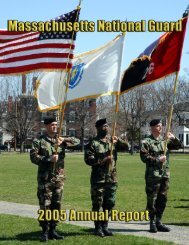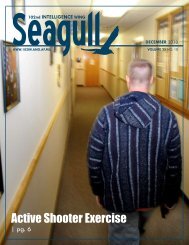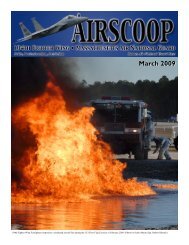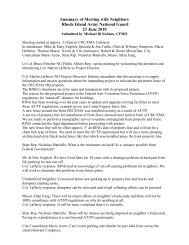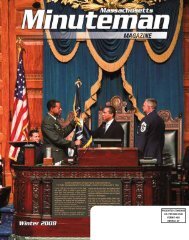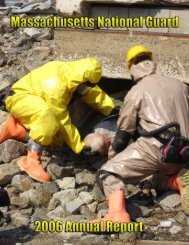Senior Management Board, January 25, 2006 - STATES - The ...
Senior Management Board, January 25, 2006 - STATES - The ...
Senior Management Board, January 25, 2006 - STATES - The ...
Create successful ePaper yourself
Turn your PDF publications into a flip-book with our unique Google optimized e-Paper software.
<strong>Senior</strong> <strong>Management</strong> <strong>Board</strong><br />
Human Services Building<br />
East Sandwich, MA<br />
<strong>January</strong> <strong>25</strong>, <strong>2006</strong><br />
6:30 – 8:15 p.m.<br />
Meeting Minutes<br />
Members: Organization: Telephone: E-mail:<br />
George “Chuckie” Green Town of Mashpee 508-539-1408<br />
Doug Dexter Town of Sandwich 5-8-833-6503 dexterselectman@aol.com<br />
Linda Zuern Town of Bourne 508-759-4101 Lzuern@townofbourne.com<br />
Virginia Valiela Town of Falmouth 508-548-7611 valielav@hotmail.com<br />
LTC Randall Cordeiro (sitting<br />
in for COL Steven Wujciak)<br />
Camp Edwards 508-968-5883 randall.cordeiro@ma.ngb.army.mil<br />
Cdr. John Healy (sitting in for<br />
Capt Tom Ostebo)<br />
USCG 508-968-6480 jhealy@ascapecod.uscg.mil<br />
Alan Cowles E&RC 508-968-5147 alan.cowles@ma.ngb.army.mil<br />
Mark Harding Mashpee Wampanoag<br />
Dave Williams (sitting in for<br />
Martha Steele)<br />
MDPH 781-774-6612<br />
Lynne Jennings (sitting in for<br />
Mary Sanderson)<br />
US EPA 617-918-1210 Jennings.lynne@epa.gov<br />
Gary Moran MassDEP 508-946-8712 gary.moran@state.ma.us<br />
Attendees: Organization: Telephone: E-mail:<br />
COL Bill Fitzpatrick E&RC 508-968-5154 Bill.f.fitzpatrick@us.army.mil<br />
Lynda Wadsworth E&RC 508-968-5152 Lynda.wadsworth@ma.ngb.army.mil<br />
Emily Derbyshire E&RC 508-968-5146 emily.derbyshire@us.army.mil<br />
Sally Hartmann E&RC 508-968-5145 sally.a.hartman@us.army.mil<br />
Hap Gonser IAGWSP<br />
Ben Gregson IAGWSP 508-968-5821 benjamin.p.gregson@us.army.mil<br />
Mike Minior AFCEE/MMR 508-968-4670 mike.minior@brooks.af.mil<br />
Jon Davis AFCEE/MMR 508-968-4670 jon.davis@brooks.af.mil<br />
Doug Karson AFCEE/MMR 508-968-4670 doug.karson@brooks.af.mil<br />
Mark Begley EMC 508-968-5127 mark.begley@state.ma.us<br />
David Dow Sierra Club 508-540-7142<br />
Sue Walker PCT<br />
Jim Quin Ellis Environmental 720-963-9346 james.quin@ellisenv.com<br />
Jane Moran e 2 M 508-759-9114 janemoran@earthlink.net<br />
Handouts Distributed at Meeting:<br />
1. Presentation handout: FS-28 Leading Edge Update<br />
2. Presentation handout: Chemical Spill 19 Update<br />
3. Map: Southwest Plumes<br />
4. Presentation handout: Remediation & Investigation Update<br />
5. Presentation handout: Groundwater Monitoring Plan<br />
Agenda Item #1. Introductions, Approval of 9/28/05 SMB Meeting Minutes,<br />
and Late-Breaking News<br />
Mr. Dexter convened the meeting at 6:32 p.m. and the <strong>Senior</strong> <strong>Management</strong> <strong>Board</strong> (SMB) members<br />
introduced themselves. Mr. Dexter asked if there were any changes to the September 28, 2005 SMB
meeting minutes. No changes were offered and the minutes were approved as written. Mr. Dexter then<br />
confirmed that there was no late-breaking news to report at this time.<br />
Agenda Item #2. Installation Restoration Program (IRP) Updates<br />
FS-28 Update<br />
Mr. Davis reminded the group that the treatment system that was built in 1999 to address the Fuel Spill<br />
28 (FS-28) plume continues to operate, and as designed, the southern part of the plume is uncaptured.<br />
He also noted, however, that more contamination at the leading edge is going uncaptured than<br />
anticipated. Also that ethylene dibromide (EDB), the contaminant of concern (COC) for the FS-28<br />
plume, was detected in surface water at the Augusta bog during the 2005 growing season, and<br />
therefore the cranberries from that bog did not go to market. Mr. Davis stated that all of the homes in<br />
that area have been connected to town water since the 1997/1998 timeframe.<br />
Mr. Davis showed a map of the FS-28 leading edge and noted that the drive-point locations depicted in<br />
green represent nondetect results; those depicted in yellow represent detections below the maximum<br />
contaminant level (MCL) for EDB, which is 0.02 parts per billion (ppb); and those depicted in red<br />
represent detections that exceeded the MCL. He also mentioned a recent sonic drilling location, not<br />
shown on the map, which tested nondetect. He then pointed out the shallow portion of the leading edge<br />
and the deeper portion of the leading edge and said that it’s believed that those areas have been well<br />
characterized. He also said that hydraulic measurements are currently being taken, after which the<br />
model will be updated in order to predict the fate of the uncaptured portion of the plume.<br />
Mr. Davis also reported that with the exception of the Augusta bog, the cranberries from all the other<br />
bogs in the Coonamessett River system were harvested and sent to market. He further noted that the<br />
EDB concentrations detected at the Augusta bog were significantly below drinking water standards;<br />
however, Ocean Spray’s policy is to reject cranberries from bogs where there have been any EDB<br />
detections whatsoever. Mr. Davis also noted that the October 2005 Plume Cleanup Team (PCT)<br />
meeting was preceded by a posterboard session on the FS-28 leading edge and included that topic as a<br />
main agenda item. At that time it was noted that surface water sampling had been done at Round Pond,<br />
but not at Jenkins Pond. Jenkins Pond has since been sampled and the results were nondetect for EDB,<br />
as expected.<br />
Questions and Comments from SMB and Public<br />
Ms. Valiela inquired about the depth of the deep and shallow portions of the leading edge. Mr. Davis<br />
replied that at drive-point 131 (DP-131) the deep part of the leading edge of the plume was detected at<br />
about 170 feet below ground surface (bgs), and at DP-123 the shallow part was detected at about 47<br />
feet bgs. Ms. Valiela asked about the depth of the detection at DP-129, which Mr. Davis said occurred<br />
at 47 feet bgs also. Ms. Valiela asked if it’s correct that the modeling will predict the fate of the<br />
leading edge. Mr. Davis replied that it is, but added that the area is very complex and there will be<br />
some uncertainty associated with the model predictions.<br />
Ms. Valiela then asked if the cranberries from the Augusta bog were harvested and measured in terms<br />
of the numbers of barrels. Mr. Davis replied that the berries were harvested and went to compost;<br />
however, the IRP is still awaiting information from the grower as to the number of barrels harvested so<br />
that proper compensation can be made, and intends to follow up with the grower for that information.<br />
Ms. Valiela asked if the IRP had verified the price per barrel. Mr. Davis replied that the IRP has an<br />
appraiser working with the Cape Cod Cranberry Growers Association to develop that number.<br />
SENIOR MANAGEMENT BOARD MEETING – JANUARY <strong>25</strong>, <strong>2006</strong> PAGE 2 OF 12
Mr. Dexter asked if the IRP had encountered any access problems while investigating the leading edge<br />
of the FS-28 plume. Mr. Davis replied that although the IRP was able to obtain access where needed, it<br />
was challenging because of the private properties in the area and the topography.<br />
CS-19 Update<br />
Mr. Davis showed a map, pointed out the Chemical Spill 19 (CS-19) plume in the Impact Area, and<br />
noted that the plume outline is based on exceedances of the health advisory for RDX, which is 2 ppb.<br />
He also showed a cross-section of the plume and pointed out an area of RDX concentrations as high as<br />
16 to 17 ppb near the source area and an area of concentrations around 4 or 5 ppb at the toe of the<br />
plume.<br />
Mr. Davis reported that the Interim Record of Decision (IROD) for CS-19 groundwater, which is in<br />
the process of being finalized, calls for plume monitoring and the implementation of land-use controls<br />
(LUCs) to prevent exposure to plume contaminants. He also noted that a permanent remedy will be<br />
selected once the Impact Area Groundwater Study Program (IAGWSP) completes the feasibility study<br />
(FS) for the Central Impact Area, which encompasses CS-19. Mr. Davis noted that the IAGWSP is<br />
probably a few years away from finishing the work in the Central Impact Area and selecting a remedy<br />
there.<br />
Mr. Davis showed an aerial view of the CS-19 source area, pointed out the perimeter road, and noted<br />
that the area was used for disposal of munitions by burial. He said that burial pits have been identified<br />
at the site and approximately 20,000 pounds of munitions debris has been removed. He also pointed<br />
out some soil piles visible in the aerial view of the site, and explained that the photo was taken during<br />
test pitting activities that were part of the remedial investigation (RI) conducted in 2003, when RDX<br />
contamination was found in both soil and groundwater.<br />
Mr. Davis noted that the model had predicted that the plume would attenuate before it reaches the base<br />
boundary if the RDX source were removed, and so an engineering evaluation/cost analysis (EE/CA)<br />
for source removal was recommended. <strong>The</strong> EE/CA source removal action commenced in fall 2004<br />
under a draft EE/CA document, before the EE/CA action memo was finalized in June 2005. Mr. Davis<br />
showed another aerial view of the site and pointed out the superimposed black line indicating the<br />
extent of the EE/CA work that was initially planned and said that the removal work there (which<br />
involves removing the majority of metal debris to the point that the soil can be sampled to determine if<br />
there’s remaining RDX that could be contributing to the plume) is almost complete. He also pointed<br />
out a superimposed yellow line outside of the black line and noted that it represents an area where the<br />
IRP will be doing some additional removal work based on EM-61 magnetometer surveys and<br />
historical clearing identified in old photos.<br />
Mr. Davis then stated that in consultation with the U.S. Environmental Protection Agency (EPA) and<br />
the Massachusetts Department of Environmental Protection (MassDEP), the IRP expanded the CS-19<br />
study area to include a bunker about 600 feet north of the original one-acre site. He showed an aerial<br />
photo and pointed out the expanded study area, and then showed a photo of the bunker, which, he<br />
noted, was used as a location from which to observe explosive activities in that area. Mr. Davis also<br />
showed an aerial photo dated 1955 and said that it was used to help define the expanded study area, for<br />
which the first step will be a supplemental remediation investigation (SRI), whose purpose will be to<br />
define the nature and extent of contamination and then do a baseline risk assessment for the<br />
contaminants that are found.<br />
Mr. Davis noted that the SRI, which will actually be the third for CS-19, will be separate from the<br />
current removal activity and will involve investigating the area for evidence of disposal activity and<br />
disposal sites. <strong>The</strong> resulting SRI report will include recommended next steps. Mr. Davis also noted<br />
SENIOR MANAGEMENT BOARD MEETING – JANUARY <strong>25</strong>, <strong>2006</strong> PAGE 3 OF 12
that the schedule for the SRI is yet to be determined. Also, that the IRP is currently seeking funding to<br />
do the work, and expects to learn sometime in the May/June timeframe when that funding will be<br />
available.<br />
Questions and Comments from SMB and Public<br />
Mr. Harding inquired about the sort of metal debris that’s being left behind. Mr. Davis replied that<br />
very small, fragment-sized pieces of metal are being left.<br />
Mr. Dexter asked about the time period when CS-19 was used as a disposal site. Mr. Davis replied that<br />
the photos indicate that the area was being used in 1955. Ms. Jennings said that some of the archive<br />
search report information suggests that the area started to be used in the late 1960s, but its use before<br />
that is uncertain.<br />
Ms. Jennings then said that she thinks there’s a possibility that in addition to fragments of metal,<br />
unexploded ordnance (UXO) may also be left behind. She said that the IRP’s approach is to remove<br />
known disposal pits; however, the magnetometer survey shows a lot of other metal debris, and unless<br />
it’s dug up and identified, it’s possible that some UXO may be left behind. Mr. Davis noted that the<br />
IRP’s UXO experts would disagree with that. He explained that the approach is to dig down a number<br />
of feet in areas indicated by the magnetometer survey, and then go over it with a Schonstedt (a<br />
handheld magnetometer). Once the point is reached that there’s no reading on the Schonstedt, it’s<br />
concluded that nothing significant has been left behind. Mr. Harding inquired as to the depth. Mr.<br />
Davis replied, “As deep as 10 feet.”<br />
Ms. Valiela asked if any pits deeper than 10 feet had been found. Mr. Davis replied that none had. He<br />
also said that three major pits had been found, one of which seems to be extending laterally, beyond<br />
the black line shown on the aerial photo. Ms. Valiela said that it’s not then a case of a kettle hole that’s<br />
been filled. Mr. Davis replied that it’s an unlikely area for a kettle hole, and said that it appears more<br />
like a landfill type of situation.<br />
Mr. Green asked if native soils are being encountered at 10 feet. Mr. Davis replied that non-native type<br />
soils continue to be seen at that depth. He also noted, however, that workers are taking readings and<br />
seeing no other metal debris below that point.<br />
Mr. Dow inquired about testing for other contaminants that might point to a liquid form type of<br />
disposal, rather than burial. Mr. Davis replied that any additional testing is conducted on samples<br />
collected from areas where burning activities are suspected. Mr. Dow noted that some plumes have<br />
been found to contain “exotic” things such as thallium and diethyl-phthalates. Mr. Davis said that as<br />
part of the RI, soil and groundwater samples were tested for a full suite of compounds and the only<br />
COC that came out of the risk assessment was RDX. Mr. Dow asked if there were any contaminants<br />
that were detected in soil but not in groundwater. Mr. Davis replied, “Nothing of significant enough<br />
levels to drive a risk, if there were.” He also said that he could provide that specific information from<br />
the RI report if Mr. Dow is interested. Mr. Dow noted that he would like to see that information.<br />
Mr. Green asked why EPA thinks that UXO still exists at the original CS-19 site. Ms. Jennings replied<br />
that the IRP is basically only removing disposal pits at this time, and it seems certain that other<br />
magnetic anomalies are being left behind. She also mentioned having heard a UXO specialist say at a<br />
meeting earlier today, “you don’t know unless you dig it up.” Ms. Jennings said that the regulators<br />
and the IRP are not in complete agreement about what’s left behind and what needs to be done and are<br />
trying to work through those issues. She also said that she thinks it would be helpful to the SMB to see<br />
some magnetometer survey maps.<br />
SENIOR MANAGEMENT BOARD MEETING – JANUARY <strong>25</strong>, <strong>2006</strong> PAGE 4 OF 12
Mr. Davis said that Ms. Jennings seems to have misunderstood what was said in today’s meeting. He<br />
noted that in fact the IRP is working on much more than just the pits. He also said that three<br />
magnetometer surveys were done, with clearing occurring after them (in all grids, not just the pits),<br />
and then a Schonstedt is being used for final clearance. He noted that the question posed to the UXO<br />
expert was whether it was possible that anything was left below 10 feet, and although his initial<br />
response was that there was nothing there, because he (Mr. Davis) is uncomfortable with “absolutes,”<br />
the UXO expert did acknowledge the possibility that there might be something there that the<br />
Schonstedt was unable to detect. Ms. Jennings asked if it’s correct that the UXO expert had said he<br />
was given instructions only to go after the burial pits. Mr. Davis replied that this is not correct, but he<br />
and Ms. Jennings also established that the burial pits are the current focus of the work. Ms. Jennings<br />
noted that it was her understanding that the magnetometer surveys pertained to the disposal pits only.<br />
Mr. Davis clarified that that is not the case; rather, the surveys were done over the entire one-acre site.<br />
Ms. Zuern inquired about the maximum depth to which the instruments can detect metal. Mr. Davis<br />
noted that a small piece of metal that’s shallow would result in a similar signal from a large piece of<br />
metal at a six or seven foot depth. Ms. Zuern asked if pieces of metal could be detected at a depth of<br />
20 feet, for example. Mr. Minior stated that the EM-61 can detect down to 10 feet, while the<br />
Schonstedt can detect down to about four feet or sometimes five, depending on the item.<br />
Ms. Valiela asked if the plan is to continue work at the site until there are no magnetometer signals.<br />
Mr. Davis replied that that is not the case. He also explained that the purpose behind the current work<br />
is to remove UXO from the area in order to conduct soil sampling and ensure that there isn’t a source<br />
there that presents a health risk or ecological impact or contributes to a plume. Mr. Davis also<br />
mentioned that the approach taken at the Demolition Area 1 (Demo 1) site was to excavate the entire<br />
area, screen the soil, and backfill the dirt. Ms. Valiela clarified that her question is not whether the<br />
entire site would be excavated, but whether the entire site, beyond just the three burial pits, would be<br />
covered by magnetometer surveys to ensure that there are no further signals. Mr. Davis replied that<br />
EM-61 magnetometer surveys have been conducted over the entire site. He also noted, however, that<br />
the only way to eliminate all signals would be to excavate the entire site, as was done at Demo 1.<br />
Ms. Jennings suggested that the IRP might want to show a final magnetometer survey map at a future<br />
SMB meeting to illustrate what the remaining metal debris looks like after the removal work is done.<br />
She also agreed that the approach at CS-19 differs from that at Demo 1, and added that in the case of<br />
CS-19 a soil cleanup level hasn’t even been determined yet, and the IRP is questioning whether the<br />
soil cleanup level used at Demo 1 is appropriate.<br />
Ms. Valiela noted that the CS-19 plume is not detached from its source, and inquired about RDX<br />
concentrations in the plume beneath the source area. Mr. Davis said that he believes that RDX<br />
concentrations there are as high as 17 ppb. He also noted that it’s believed that current work at the CS-<br />
19 site will remove any continuing source. Ms. Valiela suggested that groundwater monitoring would<br />
be an effective way to determine whether the source area has been removed. Mr. Davis agreed that<br />
groundwater data at the source will be the best indication of the effectiveness of the source cleanup.<br />
Southwest Plumes Update<br />
Mr. Davis showed a map of the Southwest plumes (CS-4, CS-20, CS-21, and FS-29) and pointed out<br />
the treatment system components: the treatment plant, influent and effluent pipeline, extraction wells,<br />
and reinjection wells and infiltration galleries. He noted that construction for the eastern part of the<br />
project has been completed, with the exception of the CS-20 leading edge extraction well, for which<br />
access had been denied. He noted that the IRP is awaiting the availability of a sonic rig to drill a well<br />
in that area and collect more data in order to determine the fate and transport of the downgradient<br />
SENIOR MANAGEMENT BOARD MEETING – JANUARY <strong>25</strong>, <strong>2006</strong> PAGE 5 OF 12
portion of the CS-20 plume, and evaluate the necessity of a leading edge extraction well. He also said<br />
that he expects a sonic rig to be available in February.<br />
Mr. Davis referred to the western part of the Southwest plumes project, pointed out where pipeline<br />
installation has been completed, and noted that work is ongoing in the Ballymeade area. He also<br />
reported that access problems associated with this phase of the project have been resolved and the last<br />
two easement offers are going out next week. He also pointed out various locations where pilot borings<br />
have been completed and noted that an effort will be made to complete as much of the work as<br />
possible before golf season begins, with an anticipated startup timeframe of May or June, depending<br />
on when NStar is able to provide power for the wells.<br />
Mr. Moran inquired about the access issue associated with Raspberry Path. Mr. Davis explained that<br />
this is the issue that pertains to the CS-20 leading edge extraction well, which he’d mentioned. He also<br />
noted that there’d been some discussion about an alternate location for that well, but the Falmouth<br />
town engineer was opposed to it because of the associated disruption to the neighborhood. <strong>The</strong><br />
engineer had also clarified, however, that he could be overruled by the Falmouth board of selectmen.<br />
Mr. Moran asked if data from the planned monitoring well are going to be used to redraw the plume.<br />
Mr. Davis replied that chemical data from the monitoring well and nearly drive-points will be used to<br />
remap the plume, migrate it, and determine how much aquifer would be affected should that portion of<br />
the plume go uncaptured.<br />
Mr. Dow asked if it would be possible to install a recirculating well at the leading edge of the CS-20<br />
plume. Mr. Davis replied that it would be possible; however, recirculating wells are much more<br />
expensive than extraction wells and not as effective.<br />
Agenda Item #3. Impact Area Groundwater Study Program Updates<br />
Remediation Update<br />
Mr. Gregson reported that groundwater Rapid Response Actions (RRAs) are under way for the J-3<br />
Range plume, which is headed toward Snake Pond, and the J-2 Range North plume, which is headed<br />
toward the Upper Cape Water Cooperative’s supply well number #2. He noted that the J-3 Range<br />
plume system components include portions of the IRP’s FS-12 system (an area in the treatment plant<br />
and an existing extraction well) and two new extraction wells. <strong>The</strong> system will treat groundwater at a<br />
rate of 175 gallons per minute (gpm). <strong>The</strong> J-2 Range North plume treatment system will be comprised<br />
of three extraction wells, two modular treatment units like those used at Demo 1, and another small<br />
treatment plant to the north. <strong>The</strong> J-2 Range North system will treat a total of 375 gpm.<br />
Mr. Gregson also reported that the Demo 1 comprehensive remedy consists of three new extraction<br />
wells, in addition to those that have been operating as part of the Demo 1 RRA system. Treatment rate<br />
at the Demo 1 plume will increase from about a half million gallons per day (mgd) to about 1.3 mgd.<br />
Mr. Gregson stated that all three of these systems are scheduled to be in place and operating within<br />
the next year.<br />
J-1 Range Investigation<br />
Mr. Gregson showed a map of the J-1 Range investigation area and pointed out the Forestdale School,<br />
Grand Oak Road, Route 130, and the Sandwich Forestdale fire station. He reminded the group that the<br />
investigation began about a year ago when RDX was detected at more than 300 ppb at a drive-point<br />
location along the base boundary. Since that time, a couple more drive-points installed up toward the<br />
suspected source area tested at about 10 ppb, and the contamination was tracked back to the southeast<br />
portion of the J-1 Range. Mr. Gregson noted that the J-1 Range had been used in the past as a defense<br />
SENIOR MANAGEMENT BOARD MEETING – JANUARY <strong>25</strong>, <strong>2006</strong> PAGE 6 OF 12
contractor testing range where disposal activities are believed to have occurred. He also pointed out<br />
drive-points that had tested nondetect, and mentioned that groundwater flow direction in that area is<br />
generally from the northwest to the southeast.<br />
Mr. Gregson reported that as part of the effort to determine the downgradient extent of the plume, the<br />
IAGWSP increased the depth of an existing IRP water table well at the fire station, sampled the well,<br />
and found that it tested nondetect. In addition, the IAGWSP installed three wells on Little Acorn Lane,<br />
a town road: monitoring well 400 (MW-400), which was installed directly downgradient of a 120-ppb<br />
RDX detection at MW-398, tested nondetect, as did the other two well locations, to the southwest<br />
(MW-402) and northeast (MW-403). Mr. Gregson noted that some contingent locations have been<br />
identified on Grand Oak Road, but the plan is to hold off on those until better information is obtained<br />
with respect to where the plume might be headed. He then mentioned that there are some private<br />
irrigation wells in the area, which were sampled and tested nondetect. He also stated that that entire<br />
area is on town water, although there are some private wells about a half mile further downgradient, in<br />
the Pimlico Pond area. Those wells were sampled and also tested nondetect.<br />
Mr. Gregson noted that the next step was to conduct a synoptic water table survey in order to obtain<br />
some near-term data on the water table configuration in that area and determine how it matches up<br />
with the modeling that’s being done. Based on information gained from that effort, the IAGWSP<br />
identified a couple of potential drilling locations on Windsong Road, a private road for which the<br />
Army Corps of Engineers’ real estate people are in the process of determining ownership so that<br />
access might be secured. Mr. Gregson also pointed out MW-360, a well on the base that originally<br />
tested nondetect but has since had an RDX detection of about 3.5 ppb. He concluded this part of his<br />
presentation by showing a photo of drilling activity in a neighborhood and photos of how a monitoring<br />
well appears once activities have been completed.<br />
J-3 Range Investigation<br />
Mr. Gregson stated that the IAGWSP has a few more locations to drill before the remedial<br />
investigation of the J-3 Range plume is considered complete. He showed a map of the area and pointed<br />
out the plume, which migrates from north to south, as well as the source area in the center of the J-3<br />
Range. He said that the IAGWSP is trying to determine whether the plume completely discharges into<br />
Snake Pond, partially discharges into it, or underflows the pond entirely. He also pointed out drivepoint<br />
407 (DP-407), located off of Snake Pond Road, which tested nondetect for perchlorate and<br />
explosives, and said that the plan is to install four additional drive-points along the southern boundary<br />
of the pond. He said that the IAGWSP recently received verbal permission from the Town of<br />
Sandwich to move forward with that work and is currently awaiting an official letter from the town<br />
before proceeding. Mr. Gregson also mentioned that before drilling begins in that area, the IAGWSP<br />
will deliver neighborhood notices and issue a news release about the work in order to keep the<br />
residents informed.<br />
Questions and Comments from SMB and Public<br />
Mr. Moran asked if it’s correct that the IAGWSP has an idea where the J-1 Range plume source area is<br />
but doesn’t know what the source is at this point. Mr. Gregson said that he thinks that’s an accurate<br />
representation of the situation. He also noted that some investigation is being conducted there in an<br />
effort to identify the source, which is thought to be “right at that entrance area to the J-1.” Mr. Moran<br />
asked if the source is thought to be a continuing source. Mr. Gregson replied that it appears to be a<br />
depleting source, given that there are still detections in the groundwater at the source area at<br />
concentrations less than 10 ppb, while farther out in the plume there are concentrations up to 120 ppb.<br />
SENIOR MANAGEMENT BOARD MEETING – JANUARY <strong>25</strong>, <strong>2006</strong> PAGE 7 OF 12
Ms. Jennings asked if Mr. Gregson could explain why MW-360 at the J-1 Range plume went from<br />
nondetect to about 3.5 ppb. Mr. Gregson replied that although there’s no clear explanation why that<br />
happened, it might be that there was a slug moving down through the vadose zone that just hit the<br />
groundwater. Whether that concentration continues to increase and indicate a source area right at that<br />
well, or whether it decreases remains to be seen. Mr. Gregson added that it does appear, however, that<br />
in that general area “there is a source area that exists to some degree, because the plume hasn’t<br />
completely detached yet.”<br />
Ms. Valiela inquired about the depth of the 120-ppb RDX detection. Mr. Gregson replied that that<br />
detection occurred at about 40 feet below the water table (bwt). He also noted that “things dive<br />
relatively quickly” close to the top of the groundwater mound. Ms. Valiela inquired about the depth of<br />
wells installed on Little Acorn Lane. Mr. Gregson replied that those were conventional wells that were<br />
drilled all the way to bedrock (about <strong>25</strong>0 to 300 feet). He also said that modeling indicated that if the<br />
plume had reached those wells it would have been seen at about 90 to 100 feet bwt. Ms. Valiela also<br />
asked Mr. Gregson to name the defense contractor that operated at the J-1 Range. Mr. Gregson replied<br />
that Textron used the range, and prior to that Hesse Eastern had.<br />
Cdr. Healy inquired about the second number in data boxes shown on the maps. Mr. Gregson<br />
explained that the second number pertains to HMX concentrations detected at the wells. He also noted<br />
that he tends to focus on the RDX data because the health advisory for RDX is 2 ppb, while the health<br />
advisory for HMX is 400 ppb, and any HMX concentrations detected are significantly below that<br />
level.<br />
Mr. Dow asked whether the fate of the leading edge of the J-3 plume (whether it discharges into Snake<br />
Pond or underflows it) would make a difference in terms of how the IAGWSP develops its treatment<br />
system. Mr. Gregson said that he thinks that depends on what’s seen on the other side of the pond, but<br />
“if this particular configuration holds up,” he expects to rely on “these two extraction wells to cut off<br />
the main mass of the plume and allow whatever’s downgradient to attenuate.” Mr. Dow asked if the<br />
model predicts that the plume isn’t going to move much farther downgradient and Mr. Gregson<br />
confirmed that it does.<br />
Ms. Walker stated that Textron bought AVCO, which had done testing on the base. She then asked<br />
whether Textron is taking any responsibility for the investigation. Mr. Gregson replied that the Army<br />
and EPA have been working with Textron to come up with a settlement agreement, which is close to<br />
being finalized. Ms. Walker noted that Textron has a great deal of money set aside for environmental<br />
issues, so she suggests that the IAGWSP pursue that avenue. Ms. Jennings noted that Textron already<br />
has taken responsibility for some of the cleanup work at the J-Ranges, and as Mr. Gregson noted, a<br />
settlement is pending.<br />
Groundwater Monitoring Plan<br />
Mr. Gregson stated that the purpose of the site-wide monitoring plan for the northern part of the base,<br />
which came into being around 1999, was to obtain an understanding of the distribution of<br />
contaminants in groundwater in order to identify plumes or areas of contamination as well as clean<br />
areas. <strong>The</strong> site-wide monitoring plan was reviewed and updated annually, and by 2005 it included 752<br />
well screens at 300 locations, being monitored one to four times a year. Analytes for the monitoring<br />
effort have been explosives and perchlorate, although sampling also has been done for a large variety<br />
of COCs, including volatile organic compounds (VOCs), semi-volatile organic compounds (SVOCs),<br />
metals, dyes, and other compounds. Newly installed monitoring wells typically underwent three<br />
rounds of groundwater sampling, after which the data were assessed and it was determined whether the<br />
well would be included in the site-wide monitoring plan.<br />
SENIOR MANAGEMENT BOARD MEETING – JANUARY <strong>25</strong>, <strong>2006</strong> PAGE 8 OF 12
Mr. Gregson said that the site-wide approach was useful in the early phases of the project, but as time<br />
went on it began to make sense to convert to site-specific monitoring plans, especially with some<br />
plumes transitioning to a remediation phase. <strong>The</strong>refore the decision was made to switch to an operable<br />
unit approach whereby a monitoring plan would be designed for each unit based on its stage of<br />
investigation. This new approach involves two types of plans: a performance monitoring and<br />
evaluation plan (PME) for areas where active remediation systems are in place, and an interim<br />
groundwater monitoring plan (IGM) for areas where investigation is ongoing and the RI/FS phase<br />
hasn’t been reached.<br />
Mr. Gregson noted that PME plans involve: treatment unit monitoring, to determine treatment system<br />
performance and breakthrough; hydraulic monitoring, to look at water levels and determine how the<br />
system is performing at startup, and over the long-term to see how plume capture is proceeding; and<br />
contaminant monitoring, which focuses on areas within and near the plume and provides a longer-term<br />
assessment of whether design goals are being met, and an assessment of contaminant distribution and<br />
plume migration. PME plans are in place or have been submitted for the Demo 1, J-2 Range North,<br />
and J-3 Range plumes.<br />
Mr. Gregson stated that the purpose of IGM plans, for plumes where treatment systems are not yet in<br />
place, is to characterize the plume, document changes in plume geometry, and support remedial<br />
decision-making throughout the FS process. IGM plans involve annual and semiannual chemical<br />
monitoring rounds that focus on areas within and near the plume to assess contaminant distribution and<br />
plume migration.<br />
Mr. Gregson displayed a table listing the various sites and the status of their associated groundwater<br />
monitoring plans. He said that the goal is to have all the plans in place and approved by April, when<br />
annual sampling rounds typically begin.<br />
Questions and Comments from SMB and Public<br />
Ms. Zuern asked if sampling and analysis are conducted automatically by some kind of computerized<br />
system. Mr. Gregson replied that such is not the case; rather, the process involves having sampling<br />
crews pump samples from wells, to be sent to the laboratory for analysis. He also mentioned the<br />
diffusion sampling approach, which the IAGWSP is considering. He said that this could be less<br />
expensive, and less apt to introduce error, and involves dropping a semi-permeable tube down a well,<br />
allowing the groundwater (and any contaminants) to diffuse into it, and eventually pulling the tube<br />
back up and removing the sample for laboratory analysis. Ms. Zuern asked if there’s anything on the<br />
market that would detect chemicals in groundwater that’s in place. Mr. Gregson replied that full-blown<br />
lab equipment is needed to conduct the kind of analyses that the cleanup program requires.<br />
Mr. Dow said that his understanding is that an IGM plan is supposed to define changes in a plume’s<br />
vertical extent or horizontal range, and he wonders how boundaries would be estimated for the model<br />
for complex areas with multiple source areas, such as the Central Impact Area. Mr. Gregson agreed<br />
that the Central Impact Area is particularly complex because there are multiple source areas and, in<br />
reality, multiple plumes or “plumelets” from each of those source areas. He explained that the<br />
IAGWSP is handling that situation by not attempting to map each plumelet individually, but instead<br />
representing them as one area of contamination. He also said that the intent of the IGM plan for the<br />
Central Impact Area is to select key wells to ensure that the plume shell as defined stays relatively<br />
constant, without changing significantly while the FS process for groundwater is ongoing.<br />
Mr. Dow questioned whether far-field investigations of the Central Impact Area plume have allowed<br />
the IAGWSP to rule out the possibility that it might be connected to the narrow plume of RDX and<br />
perchlorate at the Northwest Corner area. Mr. Gregson replied that he believes that the RDX at the<br />
SENIOR MANAGEMENT BOARD MEETING – JANUARY <strong>25</strong>, <strong>2006</strong> PAGE 9 OF 12
Northwest Corner is related to the Central Impact Area, given the groundwater modeling, the depth of<br />
the RDX there (deeper than the perchlorate contamination), and the fact that RDX would be the result<br />
of military munitions. He also said that it’s “really quite remarkable” to have such a finger of<br />
contamination that’s traveled all the way from the Impact Area to the canal.<br />
Agenda Item #4. Environmental & Readiness Center (E&RC) Updates<br />
Mr. Cowles noted that at the quarterly Environmental <strong>Management</strong> Commission (EMC) meeting in<br />
December the E&RC briefed the EMC on some changes in procedures resulting from incidents that led<br />
to compliance violations at the Massachusetts Military Reservation (MMR). <strong>The</strong> first occurred in<br />
September at the Sierra East/Sierra West and Echo Ranges when project changes to the original range<br />
upgrade plans violated the environmental performance standards (EPSs). Mr. Cowles noted that the<br />
E&RC has since met with MassDEP regarding the Massachusetts Environmental Policy Act (MEPA)<br />
process for projects, and also with the Natural Heritage and Endangered Species Program to discuss<br />
the issue.<br />
Mr. Cowles also spoke about an incident in October that brought about the institution of new<br />
procedures for Range Control. <strong>The</strong> incident that occurred was the firing of approximately 2,000 rounds<br />
of lead ammunition at an outdoor range by an Army Reserve Medical Unit. In response to that event,<br />
units must now provide written proof that they’ve reserved the Coast Guard’s indoor firing range<br />
before being given any lead ammunition from the ammunition supply point. In addition, signs were<br />
posted at the outdoor ranges stating that they are lead-free ranges, and units coming on to the outdoor<br />
ranges must provide documentation detailing the type of ammunition they were given at the supply<br />
point. Mr. Cowles also noted that a letter describing “our displeasure with what happened” is being<br />
sent up the chain of command. He further noted that in February the Adjutant General will be at MMR<br />
to address personnel participating in regular annual training about the importance of environmental<br />
stewardship and training properly in order to prevent disturbing the environment.<br />
Mr. Cowles also said that the Annual State of the Reservation Report for training year 2005 is<br />
scheduled to be released on <strong>January</strong> 31, <strong>2006</strong>. He noted that this will be the fourth annual report, and<br />
like the others, it will include details on the nature and extent of military training and activities, the<br />
environmental management program, and the status of compliance with EPSs. Copies of the report<br />
will be sent out by mail, and the report will also be available at the local libraries, on line, or by calling<br />
508-968-5143.<br />
Mr. Cowles stated that on October 24, 2005, the last guests from Louisiana, who were residing at<br />
MMR temporarily as part of “Operation Helping Hand,” left MMR to relocate elsewhere – either in<br />
the state, in another state, or back to Louisiana. He noted that this was a great community/statewide<br />
effort for which everyone involved should be commended.<br />
Mr. Cowles also reported that in November EPA conducted a no-notice multimedia inspection of<br />
Camp Edwards, the 102 nd Fighter Wing, and the U.S. Department of Agriculture (USDA) at MMR. At<br />
the out-brief EPA spoke of being impressed with the improvements since the last inspection, which<br />
had occurred ten years ago. In addition, however, EPA had also identified some areas needing further<br />
improvement, and the organizations (with the exception of USDA, for which no issues were identified)<br />
are working on those. Mr. Cowles mentioned a recent meeting with EPA in Boston where the<br />
Massachusetts National Guard detailed corrective actions taken to date and also discussed a letter of<br />
good faith that it plans to provide. He also noted that EPA’s actual report probably won’t be available<br />
for another two to four months, so the full findings from the inspection are not yet known.<br />
Questions and Comments from SMB and Public<br />
SENIOR MANAGEMENT BOARD MEETING – JANUARY <strong>25</strong>, <strong>2006</strong> PAGE 10 OF 12
Ms. Valiela asked if results from the inspection would be publicized once the inspection report<br />
becomes a public document. Mr. Cowles confirmed that they would.<br />
Mr. Green inquired about the fate of the 2,000 lead ammunition rounds. Mr. Cowles replied that they<br />
remain in or near the berms at the range where they were fired. He explained that the IAGWSP had<br />
conducted an analysis and determined that the rounds were not posing any imminent health risk.<br />
Mr. Cowles then announced that starting in February he would be gone for a month or so of active<br />
duty at the National Guard Bureau, during which time COL FitzPatrick would serve as acting director<br />
of the E&RC.<br />
Mr. Dexter inquired about the tungsten rounds being used at the base. Mr. Cowles replied, “Those are<br />
5.56 caliber for the M-16 rifle.” Mr. Dexter asked how the tungsten ammunition compares to standard<br />
ammunition. Mr. Cowles replied that from what he’s been told there’s very little difference.<br />
Agenda Item #5. Additional Comments, SMB Meeting Schedule, and Adjourn<br />
Ms. Valiela said that she thinks that the need to rotate SMB meeting locations among the four Upper<br />
Cape towns has diminished over time, and it would be less confusing and more convenient to hold the<br />
meetings at one location. She also suggested that that location be the Best Western Hotel in Bourne,<br />
which is easy to find, convenient for attendees coming from off Cape, and reasonably central to the<br />
other towns. Mr. Cowles said that between now and the next SMB Meeting his office would poll SMB<br />
members via e-mail regarding their opinions on Ms. Valiela’s recommendation.<br />
Mr. Minior noted the light agenda for tonight’s SMB meeting, and said that it might make sense to<br />
also consider the frequency of meetings – whether they should continue every other month, or less<br />
frequently such as every third or fourth month. Ms. Valiela said that a substantial agenda item for<br />
tonight’s meeting had been pulled because the presenter was unable to attend because of a death in his<br />
family. She also said that at one time the group had discussed meeting on a quarterly basis, and added<br />
that as it works out the SMB meets probably about five times a year, rather than six, for one reason or<br />
another. She also said that she likes tonight’s meeting setup/layout, with the head tables arranged in a<br />
sort of “U” shape, which she finds more conducive to conversation.<br />
Mr. Cowles then informed the SMB that the Adjutant General had asked him to look into the<br />
possibility of developing a group at MMR similar to a statewide organization in Texas called the<br />
Texas Environmental Partnership. He said that after taking a look at the organization, he concluded<br />
that this type of group already exists at MMR, and it is the SMB. However, the SMB membership is<br />
currently missing representation from the 102 nd Fighter Wing, which the Adjutant General would like<br />
to see in order to open up opportunities for more dialogue, particularly with respect to potential<br />
environmental impacts due to new missions and associated construction that could come about as a<br />
result of Base Realignment and Closure (BRAC) actions. Mr. Cowles noted that in addition to some<br />
changes in its membership, this may also mean some slight adjustments to the SMB’s charter. He also<br />
said that he is awaiting the Adjutant General’s response to his e-mail informing him that the type of<br />
organization he was looking for already exists at MMR. Mr. Cowles then asked the SMB members to<br />
give the idea of some thought as he would appreciate their feedback.<br />
Ms. Walker stated that the PAVE PAWS Public Health Steering Group (PPPHSG) is planning a daylong<br />
event in the spring to present several studies pertaining to the PAVE PAWS facility, and a few<br />
citizens, including herself, have been meeting separately to discuss how to make the event effective so<br />
that members of the public understand the studies and what is known and not known. She then noted<br />
that while the Towns of Falmouth, Barnstable, and Plymouth have historically been well represented<br />
by their respective health officials at the monthly PPPHSG meetings, such has not been the case for<br />
SENIOR MANAGEMENT BOARD MEETING – JANUARY <strong>25</strong>, <strong>2006</strong> PAGE 11 OF 12
the Towns of Bourne, Mashpee, and especially Sandwich. Ms. Walker went on to say that she is in<br />
disagreement with the active PPPHSG members about the role Dr. Albanese should play at the spring<br />
presentation meeting – they believe that Dr. Albanese should be in the audience like the rest of the<br />
public while she believes that because he’s been such a tremendous force behind the studies, Dr.<br />
Albanese should be part of the public policy panel that’s planned for the latter part of the day. Ms.<br />
Walker further noted that she considers it a public-relations error not to have Dr. Albanese participate<br />
on the panel, as the public might perceive the PPPHSG as having something to hide. She then<br />
requested that the SMB selectmen contact the public health officials in their towns and ask them to<br />
attend the next PPPHSG meeting and update themselves about the upcoming spring event, which she<br />
hopes would bring to the group some diversity of opinion regarding Dr. Albanese’s role.<br />
Mr. Dow, the acting chair of the Cape Cod chapter of the Sierra Club, noted that on November 6, 2005<br />
his group had submitted comments on the International Epidemiology Institute (IEI) health study on<br />
PAVE PAWS. He said that one of the concerns expressed was that because the IEI report is very<br />
technical and dense it would be difficult for the general public to understand “what the bottom line is.”<br />
<strong>The</strong>refore, the Sierra Club believes that some kind of science translation effort should be made in order<br />
to explain what is relevant and discuss the risk that people face not only from PAVE PAWS radar, but<br />
also the risks from non-PAVE PAWS radiation exposures, which the radiation exposure study<br />
determined were actually higher, making cumulative impacts an issue as well. Mr. Dow said that he<br />
thinks that some science translation would be warranted prior to the spring presentation meeting, and<br />
also at that meeting, perhaps by individuals like Dr. Albanese. He then recommended that the SMB<br />
arrange for a briefing by a representative of the PPPHSG regarding its spring presentation meeting so<br />
that SMB members could provide input on the meeting’s content, which the Sierra Club believes<br />
should be less about technical details and more about policy implications. He further noted that the<br />
Sierra Club’s opinion is that it would be a serious mistake not to involve Dr. Albanese in the policy<br />
panel.<br />
Ms. Walker asked whether the SMB had been briefed about the Impact Area Review Team<br />
(IART)/PCT merger concept. Ms. Valiela replied that she read an e-mail that made her aware of the<br />
concept, but she doesn’t think the SMB has been systematically notified. Ms. Walker noted that the<br />
subject was discussed at this month’s PCT meeting and IART meeting, and her opinion is that while<br />
such a merger will inevitably occur at some point in the future, she believes that it would be premature<br />
for that to happen at this time. She said that the IART has a great deal of work to do because the<br />
program is primarily in the investigation phase, and the PCT is dealing with IROD-to-ROD issues,<br />
annual reports, and the occasional problems that arise with the existing cleanup systems. She also said<br />
that she wonders whether all of the groundwater plumes have even been found.<br />
Ms. Walker further noted that when the time is right for the two teams to start coming together, she<br />
thinks that they should attend each other’s meetings and orientation sessions should be held. She also<br />
mentioned that both teams are dealing with plumes near Snake Pond in Sandwich and that the PCT is<br />
concerned with the CS-19 plume, which is located in the Impact Area; therefore, she thinks that each<br />
team could benefit from the other with respect to these issues. Ms. Walker also noted that she is<br />
sharing her thoughts now about something that may occur down the road because she is moving to<br />
California soon and this will be her last SMB meeting.<br />
Agenda Item #6. Adjourn<br />
Mr. Dexter noted that the SMB will meet next on March 22, <strong>2006</strong>. He then adjourned the meeting at<br />
8:18 p.m.<br />
SENIOR MANAGEMENT BOARD MEETING – JANUARY <strong>25</strong>, <strong>2006</strong> PAGE 12 OF 12




